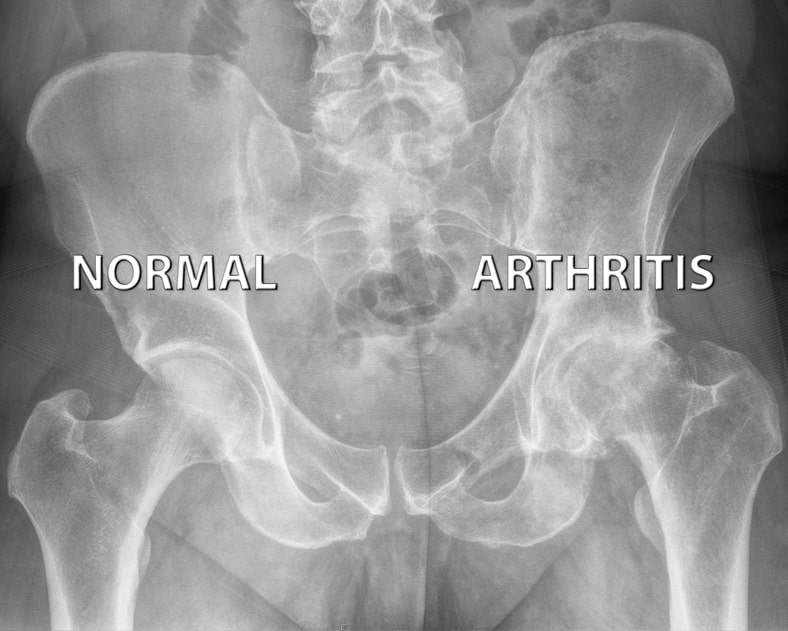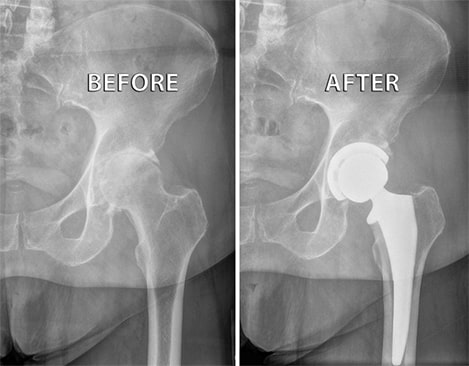Total Hip Replacement Surgeon in Georgetown, Murrells Inlet, SC.
Joint conditions such as arthritis may cause damage to the cartilage and bones leading to chronic pain in the hip and/or disability. The condition can be treated by replacing the damaged parts with artificial components. Christian J. Eccles, M.D. provides expert diagnosis and hip replacement surgery in Georgetown, Murrells Inlet, SC. Christian J. Eccles, M.D. also provides the highly specialized care during and after the surgery. Contact Christian J. Eccles, M.D.’s office for an appointment today!
What is a Total Hip Replacement?
Total hip replacement, also called total hip arthroplasty, is a surgical procedure in which the damaged cartilage and bone are removed from the hip joint and replaced with artificial components. The main indication for total hip replacement is arthritis.
Arthritis is the inflammation of joints, which results in pain, swelling, stiffness and limited movement. Hip arthritis is a common cause of chronic hip pain and disability.

Symptoms of Hip Arthritis
The hip is made up of the femoral head (top of the thigh bone) and acetabulum (socket of the pelvis). These two bones have soft cartilage ends that serve as a cushion and allow for smooth pain-free motion. Arthritis (inflammation of the joints), injury or other diseases of the joint can damage this protective cartilage layer. In an arthritic hip, the cartilage itself becomes thinner or completely absent where the bone ends often grind on each other. The most common symptom of hip arthritis is front-based groin pain and lack of motion. This pain and stiffness often causes limping and difficulty walking.
Diagnosis of Hip Arthritis
Diagnosis is made by evaluating your medical history, performing a physical examination, and taking X-rays of the painful joint.

Indications for Total Hip Replacement
Total hip replacement surgery is commonly indicated for severe osteoarthritis of the hip. Osteoarthritis is a type of arthritis. It is the most common form of hip arthritis in which the joint cartilage gradually wears away, and often affects the elderly. You may be a candidate for a total hip replacement if you have:
- Failure to obtain pain relief from medications, physical therapy or other conservative treatments
- Severe hip pain that limits your daily activities (such as walking, getting in and out of a car, or climbing stairs)
Total Hip Replacement Procedure
The goal of total hip replacement surgery is to relieve pain and restore the length of your hip before it had arthritis.
- The surgery is performed under a spinal block or general anesthesia. During the procedure, a surgical cut is made over the hip to expose the hip joint. The surface of the socket is cleaned and the damaged or arthritic bone is removed using a reamer. The acetabular cup component is inserted into the socket in a press fit manner, or occasionally using screws or bone cement. A liner made of plastic, is placed inside the acetabular component and serves as a smooth gliding surface.
- The femur or thighbone is prepared by removing the arthritic femoral head portion and preparing the femoral canal to accept a metal femoral component. This femoral component is then inserted into the femur either by a press fit or using bone cement. Then, the femoral head ball component made of ceramic is placed on the femoral stem. Both sides of the hip joint with the new components are put in their proper positions together. The entire joint is then irrigated and cleaned with a sterile solution. The incision is carefully closed and a sterile dressing is placed over the incision.


Total Hip Replacement Approaches
There are two main surgical approaches to the hip, the anterior (front) approach and the posterior (back) approach. The implants and the overall outcome are the same. There are some specific risks and benefits of each.
- Learn more about Anterior Hip Replacement here:
https://www.southcarolinahipandknee.com/anterior-hip-replacement-hip-knee-replacement-specialist-georgetown-murrells-inlet-sc/ - Learn more about Posterior Hip Replacement here: https://www.southcarolinahipandknee.com/posterior-hip-replacement-hip-knee-replacement-specialist-georgetown-murrells-inlet-sc/
Postoperative Care following Total Hip Replacement
After undergoing total hip replacement, you will be given instructions of some of the common precautions that you should take for the first few weeks as your body recovers. Most patients are able to walk as much as they want immediately after surgery but will need a walker or a cane for a few weeks. Slowly increase your activity and over time the goal will be that you can get back to things that your hip arthritis prevented you from doing before surgery.
Risks and Complications of Total Hip Replacement
- Infection
- Dislocation
- Fracture of the femur or pelvis
- Injury to nerves or blood vessels
- Formation of blood clots in the leg veins
- Leg length inequality
- Wearing out of the hip prosthesis
- Failure to relieve pain
- Loosening of the implant
If you would like to have additional information on the treatment of hip arthritis or would like to learn more about total hip replacement, please Contact Christian J. Eccles, M.D., serving the communities of Georgetown, Murrells Inlet, SC.


